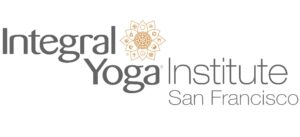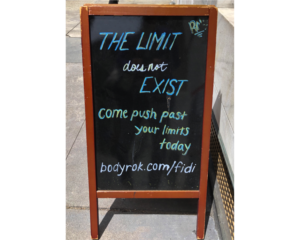By Katharine Bierce
The other day I walked past a sign at an exercise studio that said, “The limit does not exist. Come push past your limits today” as a way to try to entice people to come in to exercise.
Seeing stuff like this makes me angry.
Angry because it suggests that you need to do more, better, harder, faster, stronger. It’s an attitude of striving, pushing, and doing, possibly to the point of overdoing.
Western culture is obsessed with more, more, more. But ever-increasing consumption leads to waste. Growth for its own sake is what cancer does.
Burnout doesn’t help anyone.
Pushing harder when you’re stressed out is not useful.
And last but not least, blowing past “limitations” is an excellent way to injure yourself.
I think a better, more productive, and more mindful approach to movement comes from the yoga tradition. (Don’t get me wrong: Cardio is important too, but the attitude towards your wellness practice matters.)
Zen teacher Suzuki Roshi said, “You are perfect just as you are. And you could use a little improvement.”
To Work With Limitations, Study Yourself
Intelligent growth of understanding your limits, working with them, and breathing through your experience in a way that ultimately expands what’s possible, all while cultivating an attitude of self-acceptance… that’s what I specialize in.
I have several yoga students who have done physical therapy and are recovering from injuries, and what’s most helpful is to focus on what you CAN do, not what you can’t.
In yoga, when you can maintain a smooth, steady breath (such as Ujjayi pranayama) in a yoga pose, that’s a signal from your body that it’s okay to go further. If you find that you are not focused on the breath, if the breath is choppy, or if you’re holding your breath to try to “get through it,” that’s a sign that you may be over your edge, or backing off would support your practice more. In contrast to going to the gym, turning on the TV, and checking out while doing cardio (hey, I love watching TED talks on a treadmill too!), yoga is more about “checking in” and increasing your capacity to notice and be with your physical, mental, and emotional experience. Even while doing abs or holding poses for a while. Even when a pose feels challenging.
Limitations (like past injuries, a fixed mindset, etc.) are something to practice with, to bring breath and attention to, not something to “push” against (because by pushing, you encounter resistance). By allowing, or bringing a more yin or feminine energy to hard attitudes or stuck places, you might find more possibility than a yang or masculine energy attitude of doing, striving, or pushing. (Side note: yin and yang are co-essential, non-hierarchical opposites. Each person regardless of gender has both masculine and feminine energies, and we need both to stay in balance. However, Western culture tends to value the masculine over the feminine: doing over being, taking over receiving, obvious over mysterious, etc.
By building the capacity to maintain the focus on the breath, keeping a smooth, steady breath, and feeling what’s going on as it happens, you can build the skill of working with your limitations. And growing your practice intelligently, without forcing.
One of Patanjali’s yoga sutras is Sthiram sukham asanam: the yoga posture (asana) is characterized by a balance between strength/effort (Sthira) and ease (sukha).
Mindfulness of the breath and bodily sensations helps you stay “in the zone” so that you’re not overdoing it (which can lead to injury) or under-doing it (which isn’t going to challenge you to grow).
Cultivate Self-Understanding
No matter what’s going on in your body or mind, having a felt experience of understanding what works and what doesn’t is a skill you can use your whole life.
What do you want to cultivate in your practice? In your life? Wouldn’t it be more useful to understand your mind and body better and build self-compassion along the way, too?
This article was originally posted on Business Casual Yoga website, which offers ideas and resources for yoga and meditation practitioners who want to integrate wellbeing into a busy schedule.
 Katharine is a yogi and a techie who begins her day with meditation and movement practices. She likes supporting others in finding ways to integrate mindfulness and compassion into their busy lives. Although she started practicing yoga as a teenager, she really got hooked on yoga while putting in 12 hour days as a consultant in New York City. She completed her first 200-hour yoga teacher training in 2014. Katharine cares about guiding people in developing attention, awareness, and self-acceptance, and she is also especially passionate about helping people with injuries to incorporate yoga as part of their healing journey.
Katharine is a yogi and a techie who begins her day with meditation and movement practices. She likes supporting others in finding ways to integrate mindfulness and compassion into their busy lives. Although she started practicing yoga as a teenager, she really got hooked on yoga while putting in 12 hour days as a consultant in New York City. She completed her first 200-hour yoga teacher training in 2014. Katharine cares about guiding people in developing attention, awareness, and self-acceptance, and she is also especially passionate about helping people with injuries to incorporate yoga as part of their healing journey.

